
|
An Alphabetic Album Of Crystals A-M
Richard L. Howey, Wyoming, USA |
It occurred to me that an alphabetical approach to exhibiting some of my recent and ancient images would allow a display of a wide variety of types and substances and I hope to provide a bit of fun for you. This album will be different from the previous alphabetical one in that many of the best images are a combination of more than one substance, so I will alphabetize according to which letters I need to “fill”; in other words, I shall follow my own arbitrary whimsy.
A is for Ascorbic acid which is the primary component in your Vitamin C tablet. This is a delightful substance to work with because it is versatile, has some standard patterns, is relatively easy to work with, and often produces surprising results when mixed with other reagents. The first image shows 2 typical aspects in Ascorbic, the disk and the Maltese cross. In this example, the disks are somewhat distorted, but look very much like the pyrite “dollars” from coal mines.

Here’s a pyrite “dollar”; it’s about 4 inches across.

Occasionally, one gets really lucky and finds a superb disk with a distinct Maltese cross and a feathery fringe. It has a wonderful burnished, metallic cast with lovely subtle colors around the edge.

If you’re one of those who celebrates Valentine’s Day, you might even happen across a heart suitable for a card.

Wild swirls are also possible with elongated, curling arms comprising the Maltese cross.

And finally, you may come across a fused cluster of disks with a highly metallic character and a feathery background.

B is for Benzoic acid. It is used for a variety of industrial and household products. It is found in medications used on the skin, in insect repellents, and a food preservative to prevent bacterial growth.
Under the microscope, with polarized light, the crystals reveal a wide variety of forms and a vivid display of colors. I’ll show you some examples which I find pleasing. CAUTION: This substance can be toxic in powdered form, concentrated liquid form, or when heated. If you work with this you MUST use only dilute solutions and very low heat, otherwise you risk possible toxic gas and/or explosion. Take all necessary safety precautions!
The slide for these images is a mixture of Ascorbic acid and a weak solution of Benzoic acid. The combination was heated briefly and produced interesting results with no complications.
Here’s where my pareidolia runs rampant again and I see patterns where there aren’t any (or some nonsense like that). Anyway, the image below is, to my weak mind, clearly an alien mimicking a Picasso painting.
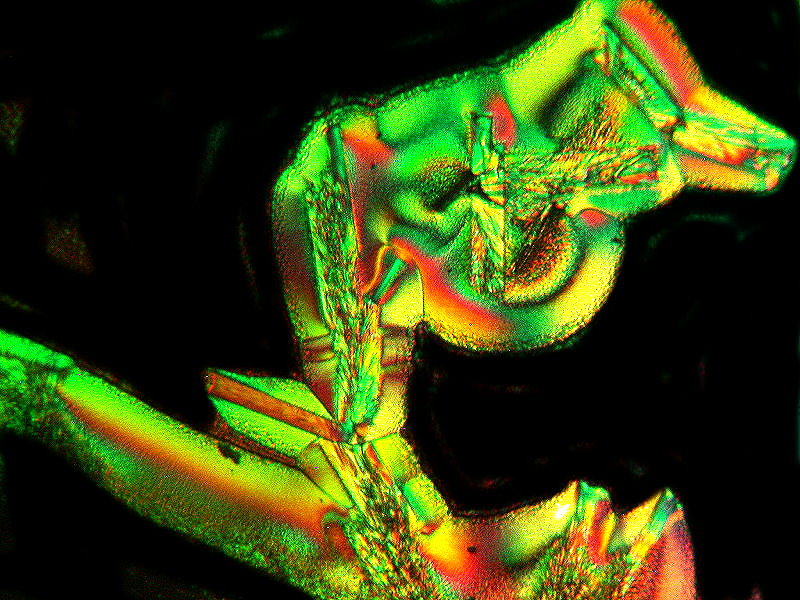
And here is its embryonic state.
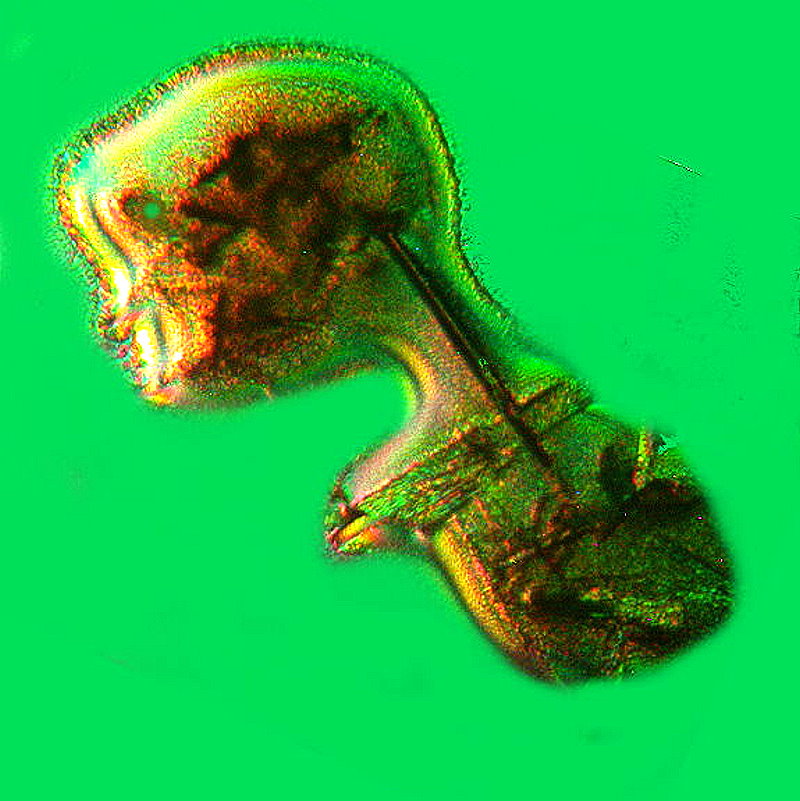
Next up is a large bird and a wee bird.
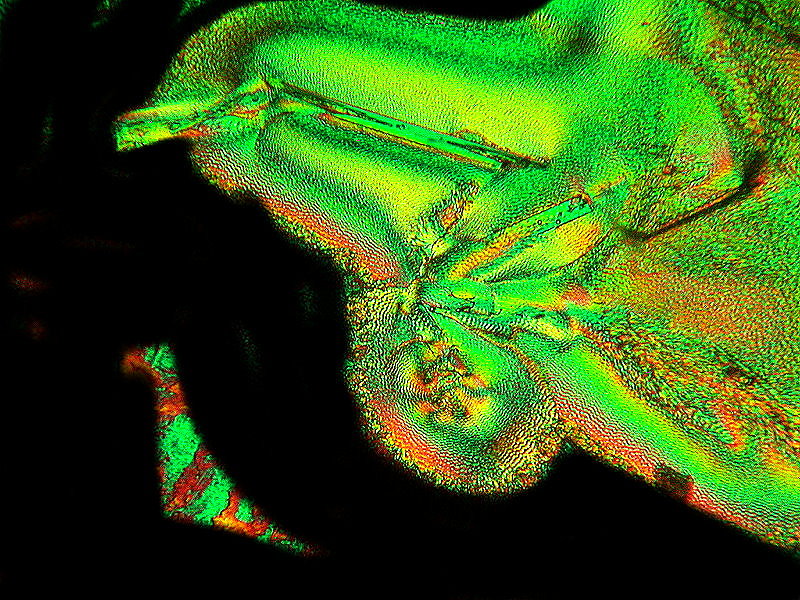
The range of forms of this chemical combination is intriguing and we find rather blocky forms such as the next one followed by slender crystals comprising what could be some kind of spiky weapon or maybe a modernistic pizza cutter.
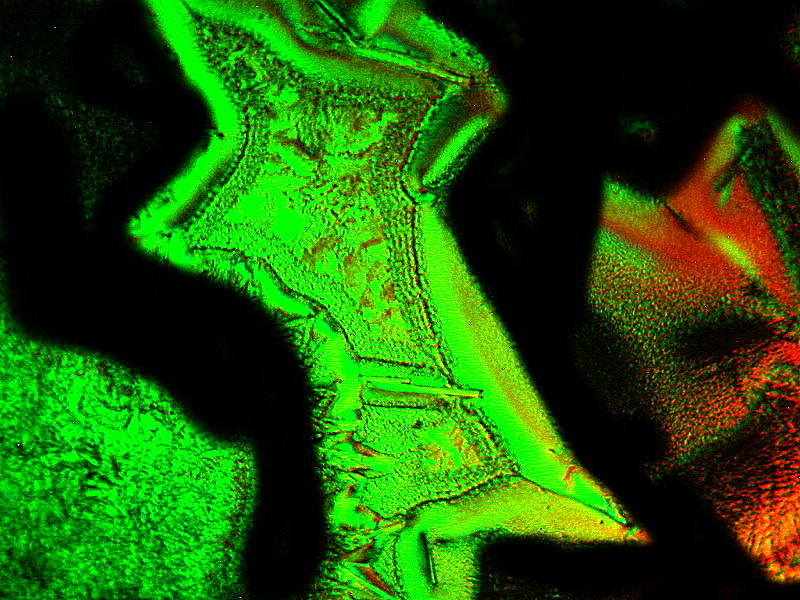
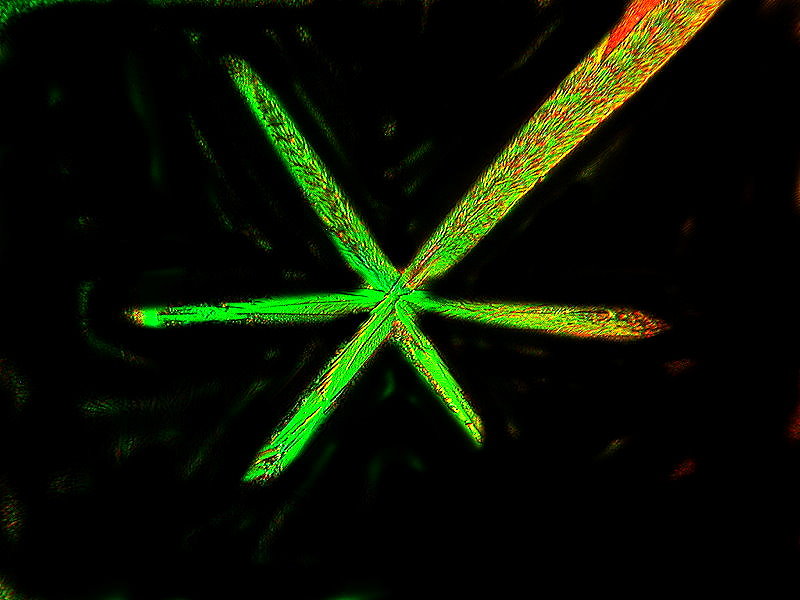
Although all of these images were taken from the same slide, in the next 2 images we see Ascorbic acid asserting itself. In the first one, we once again encounter the distinctive disk but, this time, without the Maltese cross. In the second image, we once again see the feathery formations.
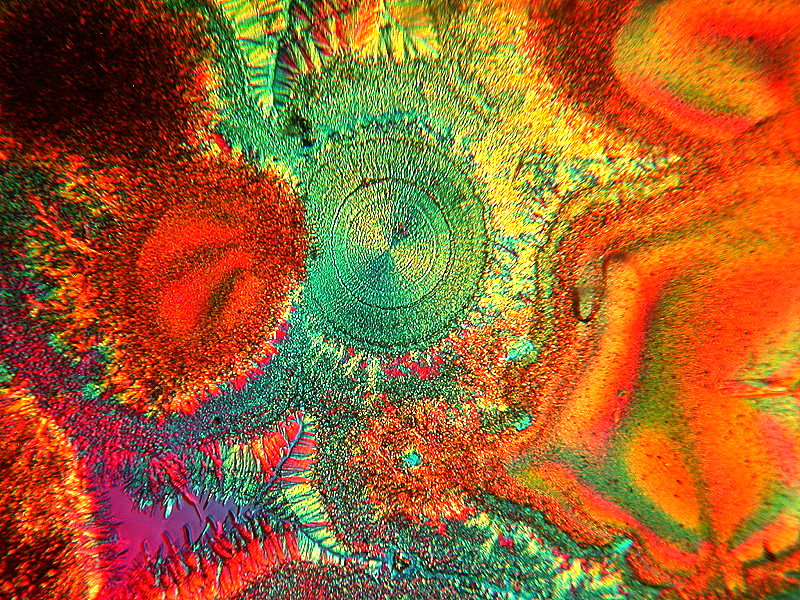
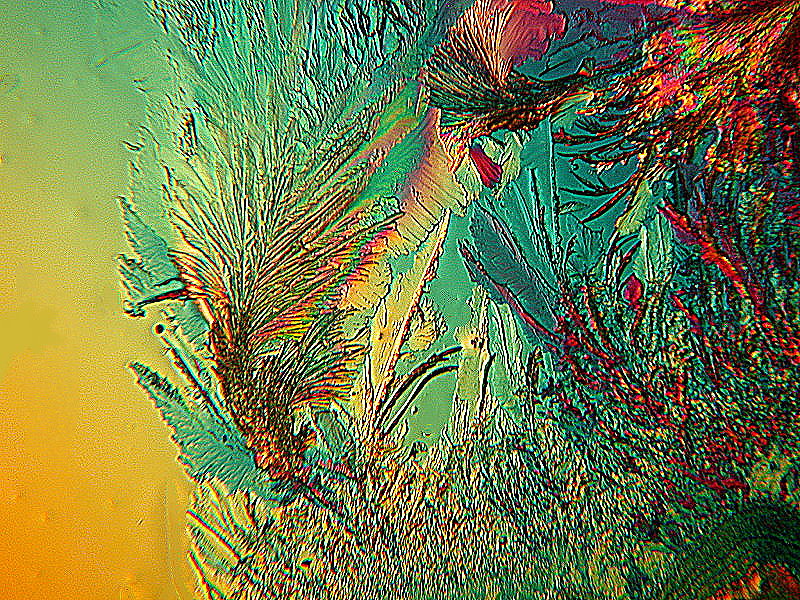
C is for Citric acid, not mixed with any other reagents. Here we can see certain patterns which remind us of Ascorbic acid even though the 2 are chemically different. In the first image, we see a distorted disk form and here there is no hint of a Maltese cross.
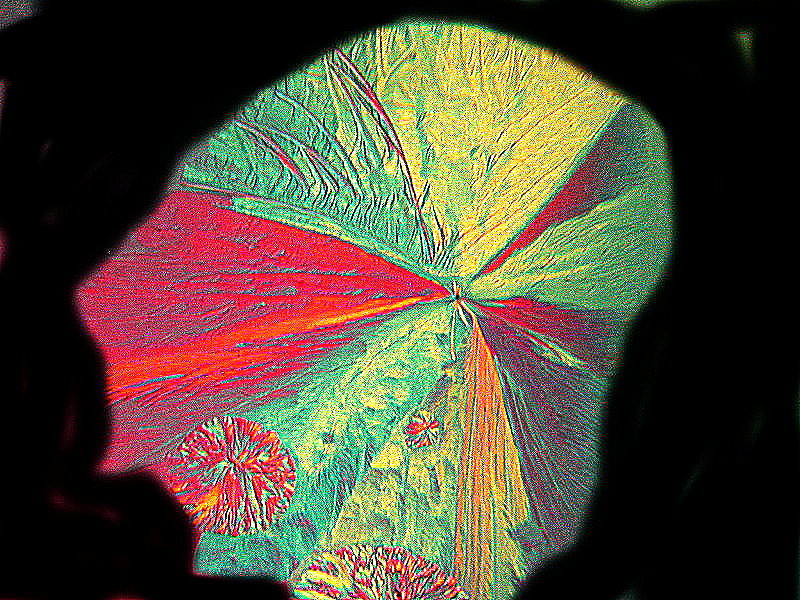
This next image is, to my mind, even more interesting in that it looks like 2 distorted disks joined at the center forming a flowing form that is sculptural in character.
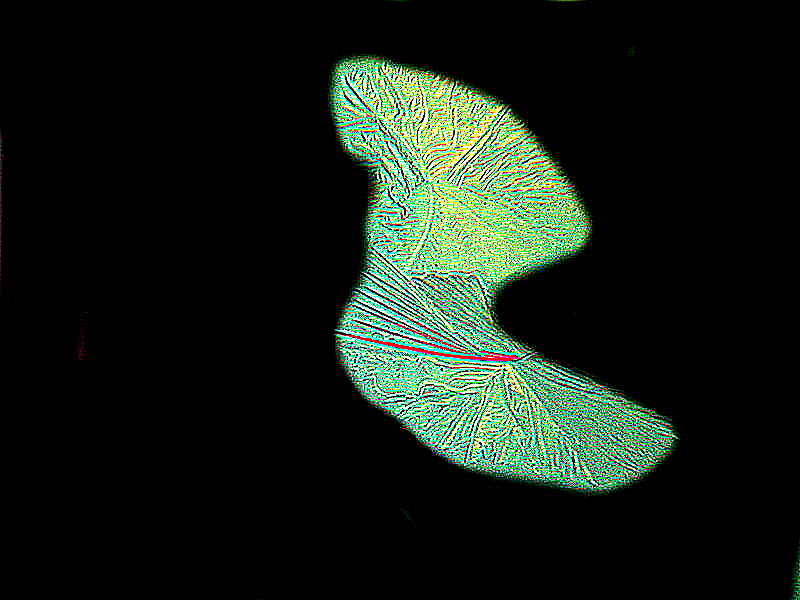
Next, somewhat surprisingly, we get a quite elegant, feathery form which almost appears to be floating as though on a gust of wind.
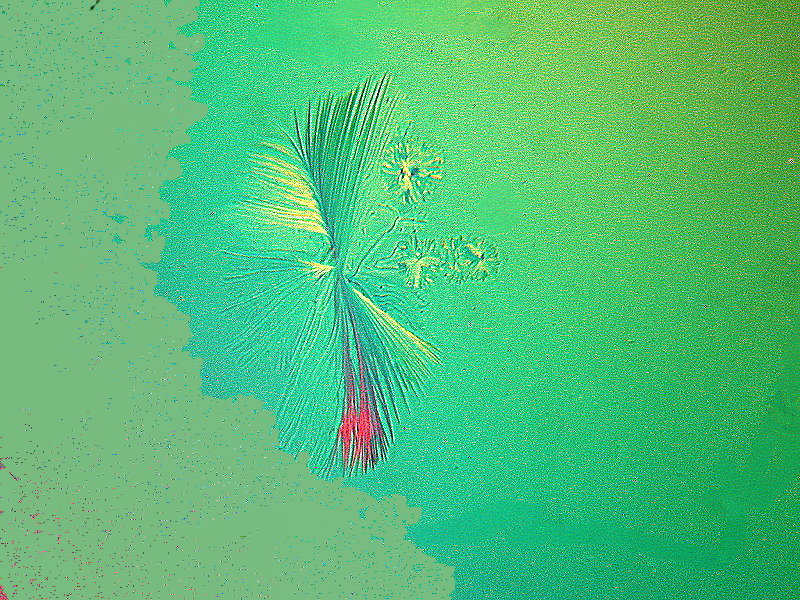
Then 2 feathery, colorful disks overlapping slightly.
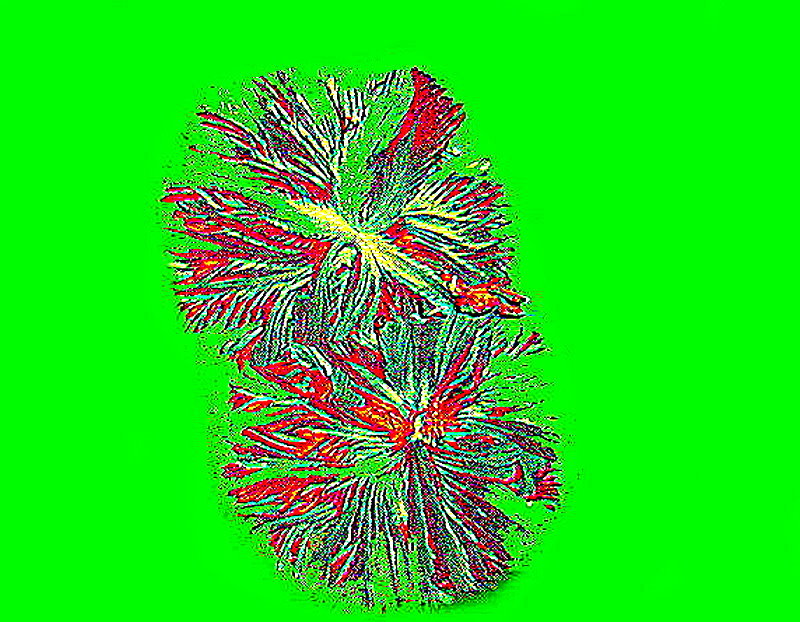
And finally, a large disk looking like an asteroid leaving a fiery trail as it plunges through an atmosphere.
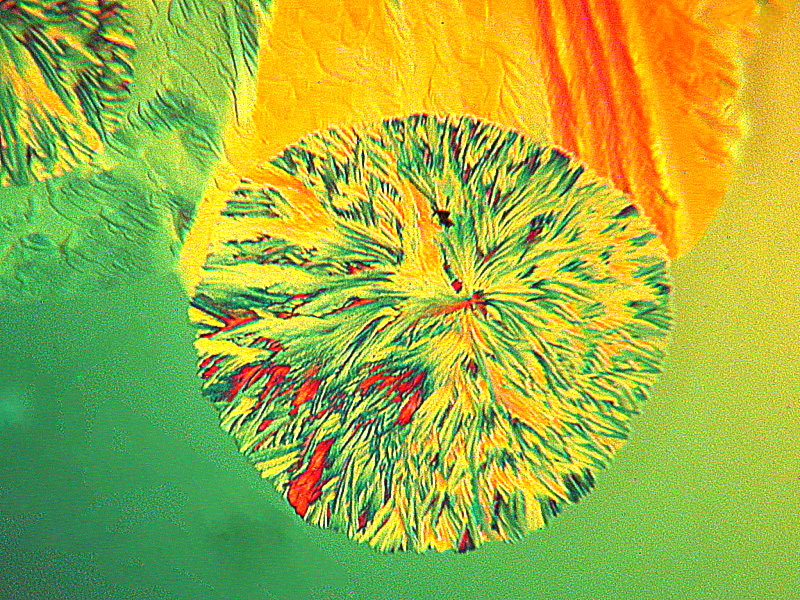
D is for Dipotassium phosphate and Dextrose; you get a double with this letter. I am particularly fond of Potassium salts as I have gotten a range of excellent, interesting crystals from them that have provided intriguing images. All of these images are from a mixture of the 2 and were formed by slow evaporation from an aqueous solution.
This first one makes me think of some ancient chest found at an archaeological site.
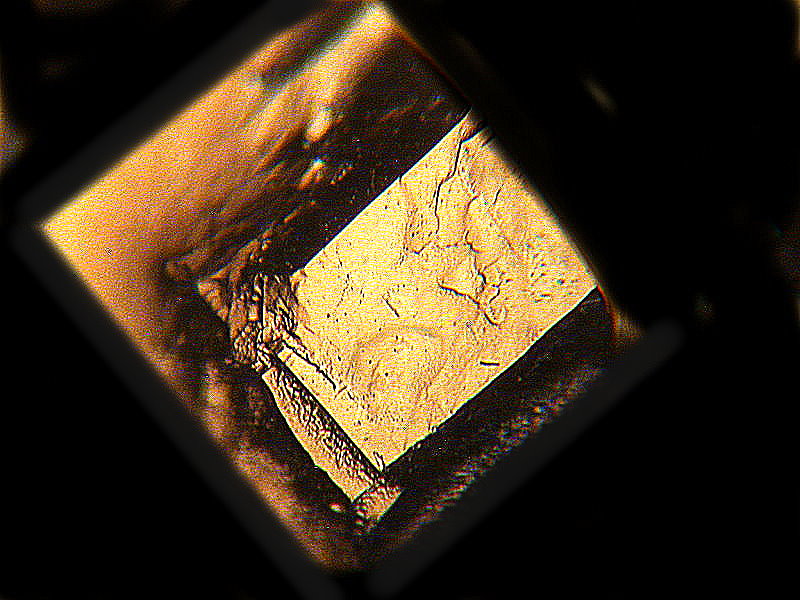
If you think something’s fishy, you might well be right and as you can tell at a glance, this is an ancient piscine type possibly related to the Coelacanths.
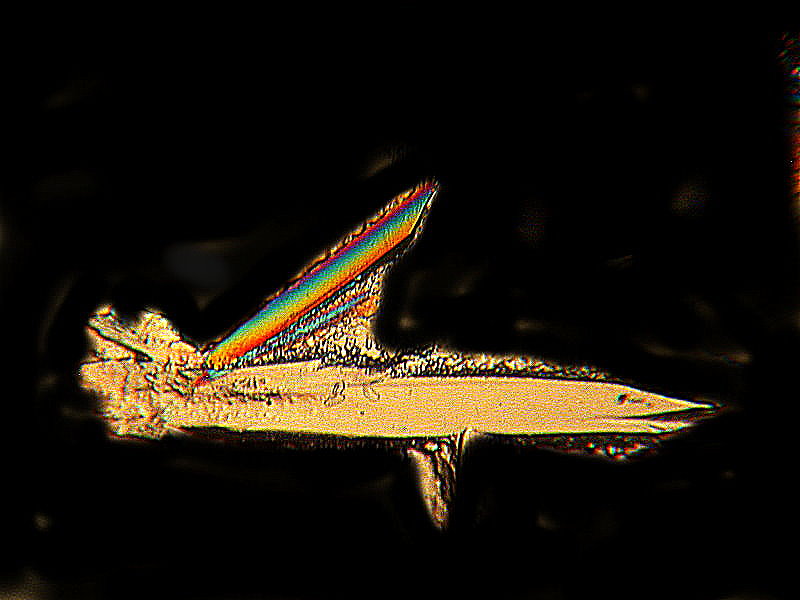
And, for those of you, who prize ornate snuff boxes, we have just the thing.
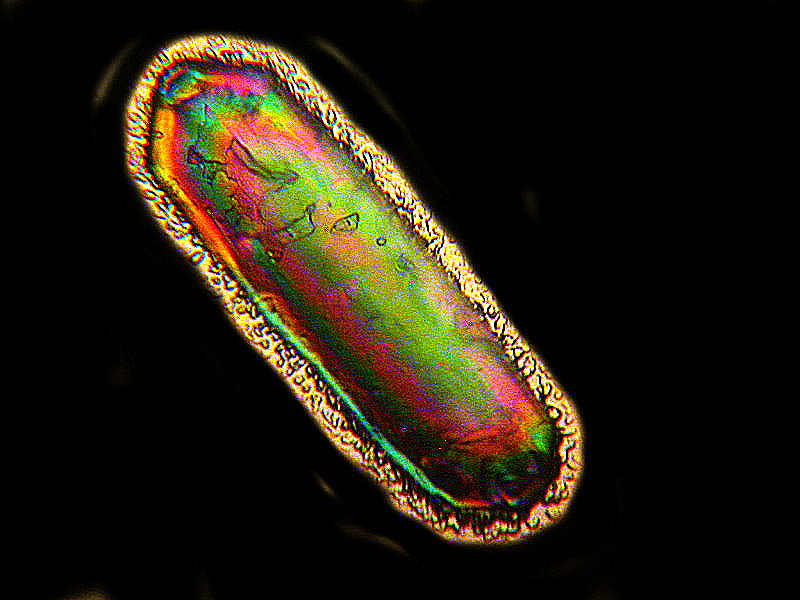
Sometimes clumps of crystals are interesting just for the way in which they merge and take on unexpected colors like the delicate purples here.
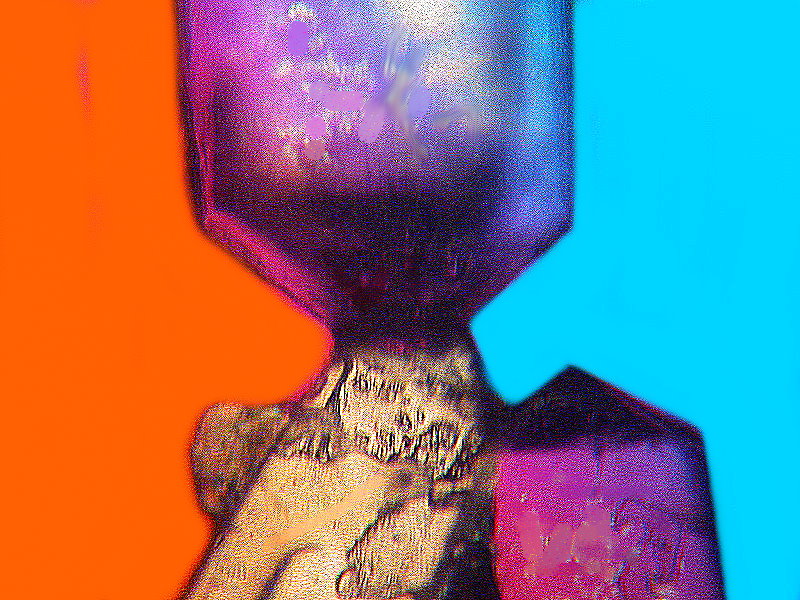
And, finally, we have definitive proof that some aliens had a sense of humor as is demonstrated by this slab with a cartoon character on it.
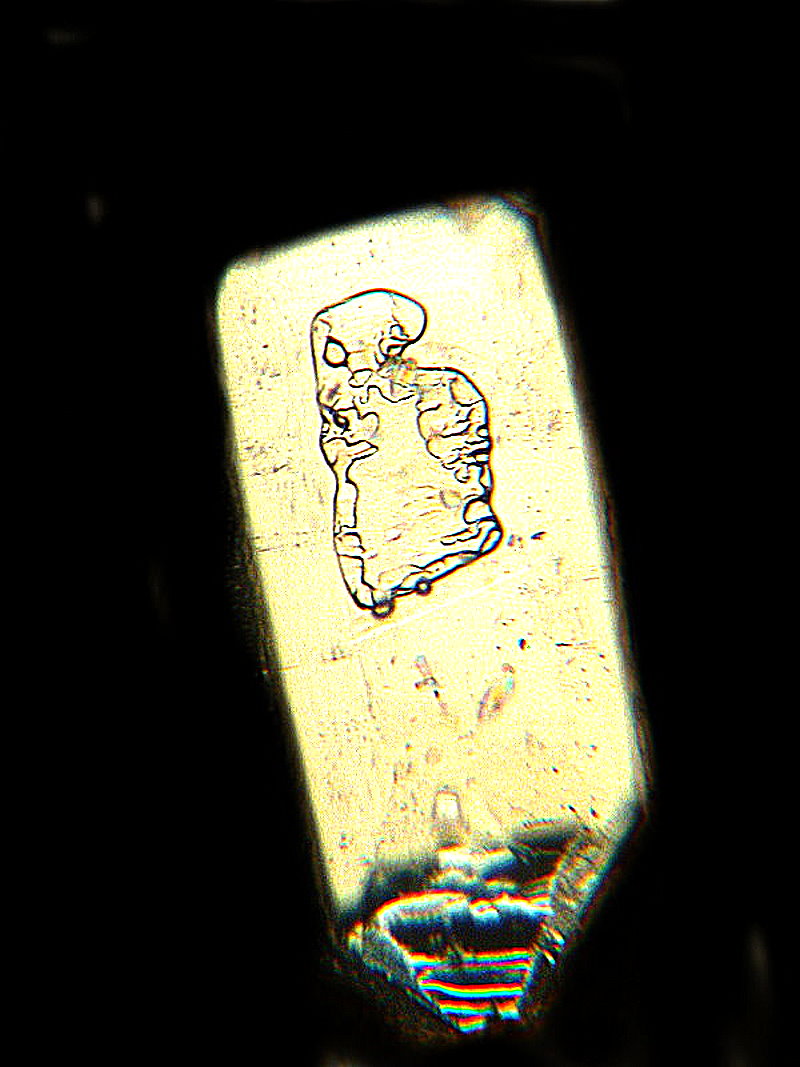
E is for Eosin which is a biological stain and when mixed with various crystalline substances can produce some dramatic results.
I’m going to show you 2 mixtures. The first is Eosin with some Bromoseltzer which you can’t get anymore because of the toxicity of bromine salts with long term use. A friend of mine had one of the old blue bottles still containing some of the original stuff and he kindly gave it to me to experiment with. I’ll show 2 images from that combination. The first looks like some very dramatic cosmic event.
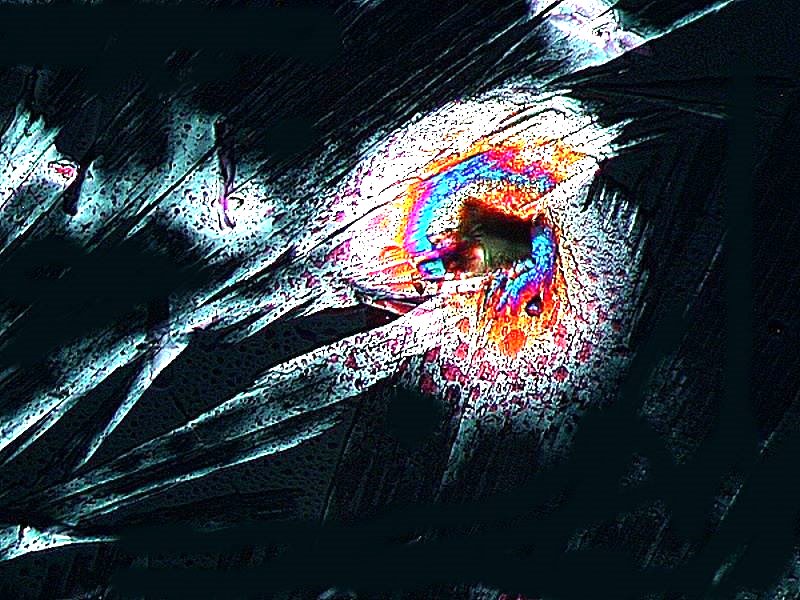
In the second image we get a very different sort of formation with the blocky forms of a cybernetic dinosaur from a planetary system in Rigel, the brightest star in Orion.
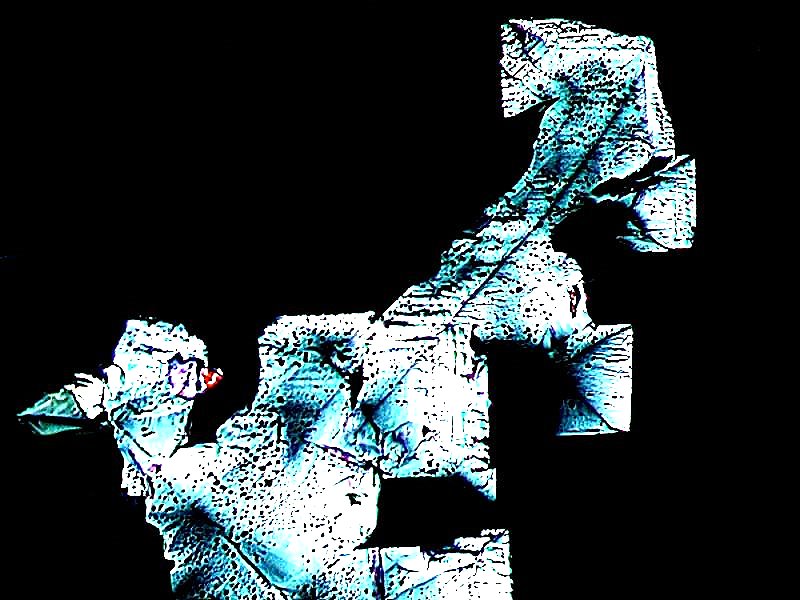
Next, I’ll show you 3 examples of the mixture of Eosin and Magnesium chloride, which is a wonderful salt in that it creates enormous numbers of tiny highly geometric crystals which I find highly pleasing.
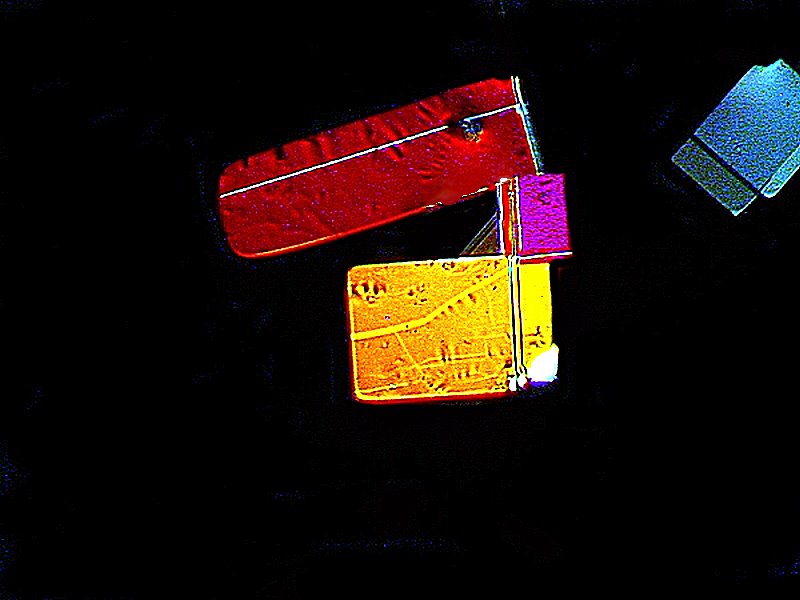
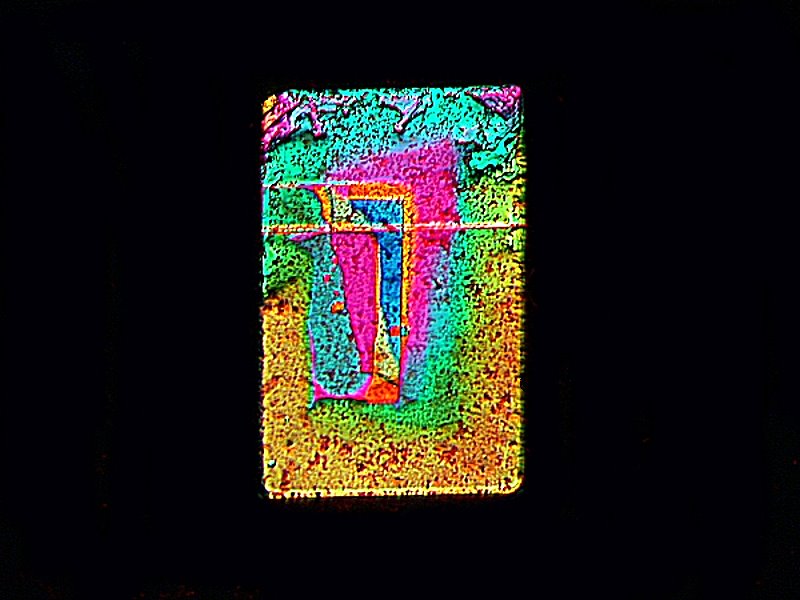
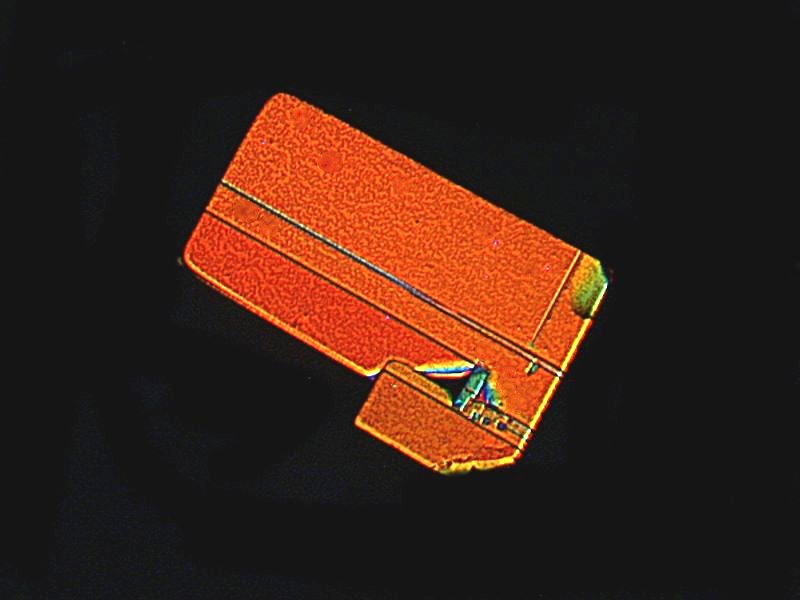
F is for Ferric ammonium sulfate. I’ll show an image of this substance by itself and then one with Ascorbic acid and 2 with Urea. This first image is unusual in that there are areas of regularity bound by other areas of clumpy clutter.
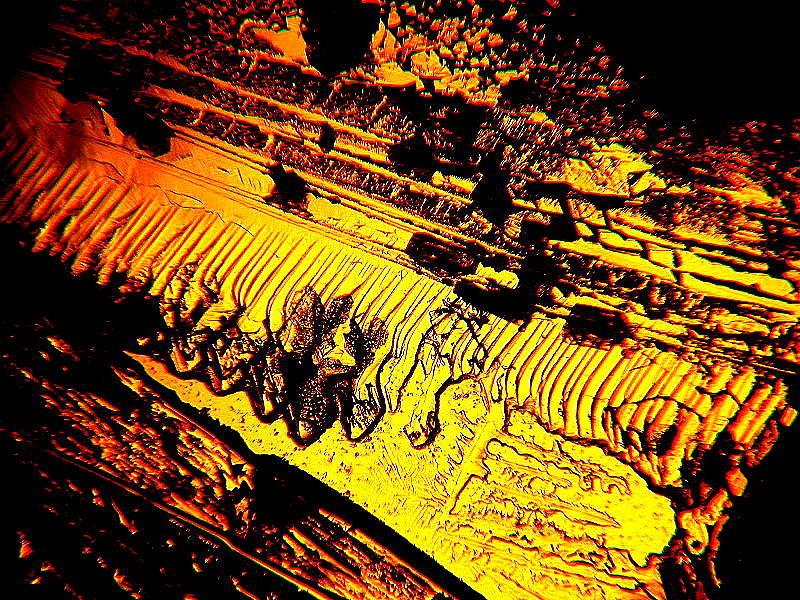
The mixture with Ascorbic acid is much more interesting and looks rather like the head of a very furry canine.
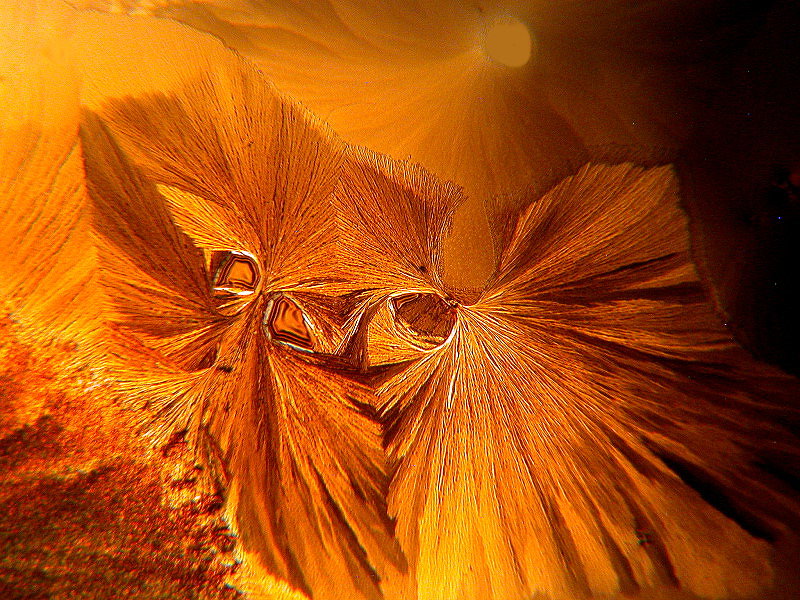
The 2 with Urea, I like both for form and color; they convey a sense of vivid structure.
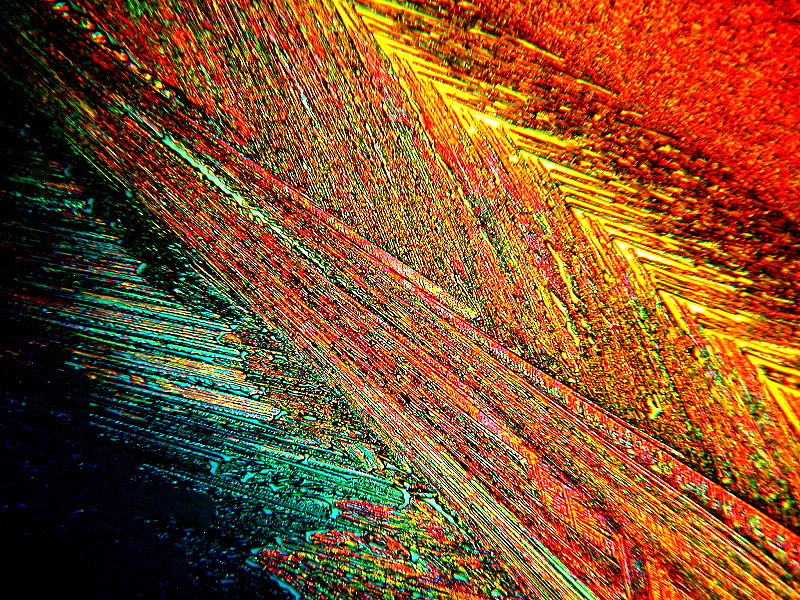
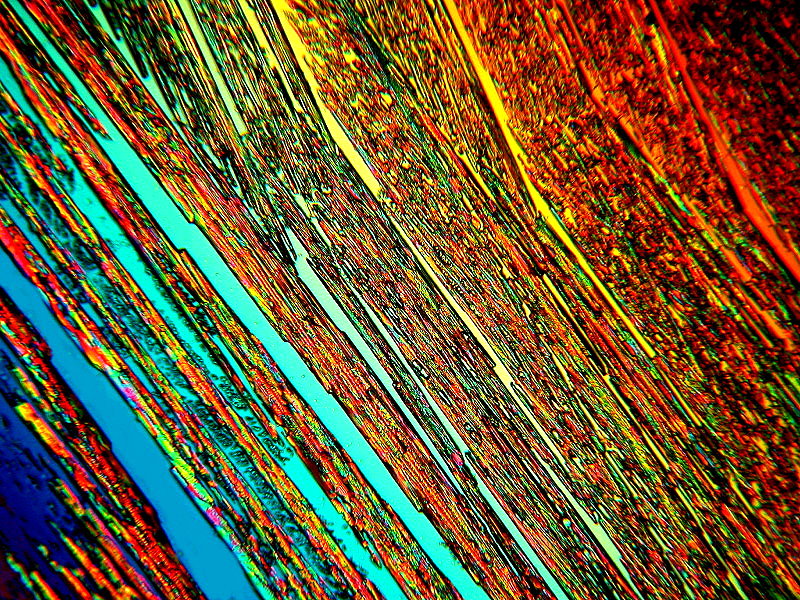
G is for Gabapentin, an anti-seizure medication. I’ll show you several combinations. The first is a rather strange one which consists of Gabapentin, Elmer’s Gel Glue, and the biological stain Orange G and the results are surprising. The first 2 show single red and green disks amid large masses.
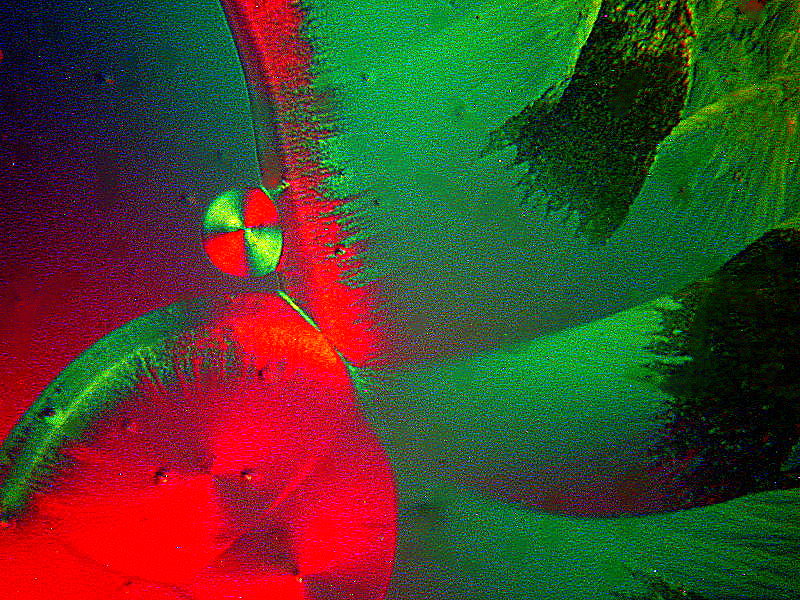
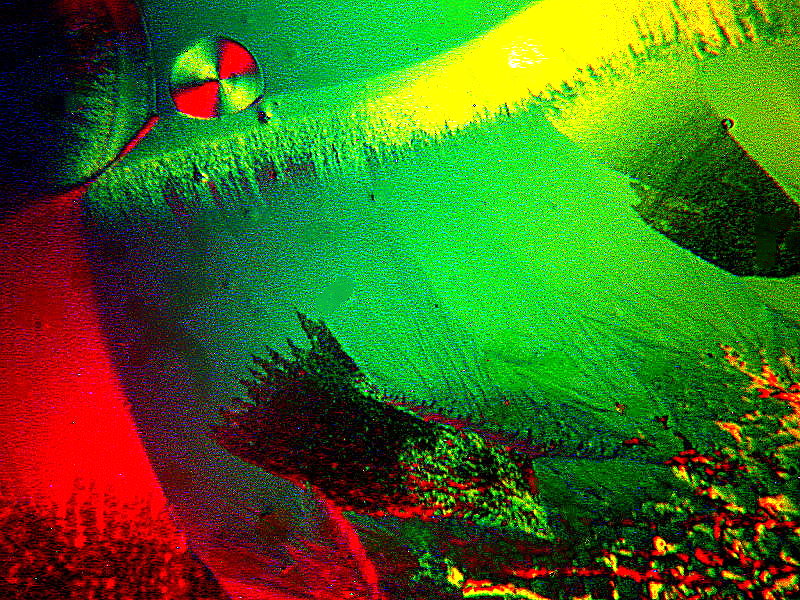
The next 2 are even more remarkable; the first reminds me of a planetary system and the second an aerial view of a pock-marked moon.
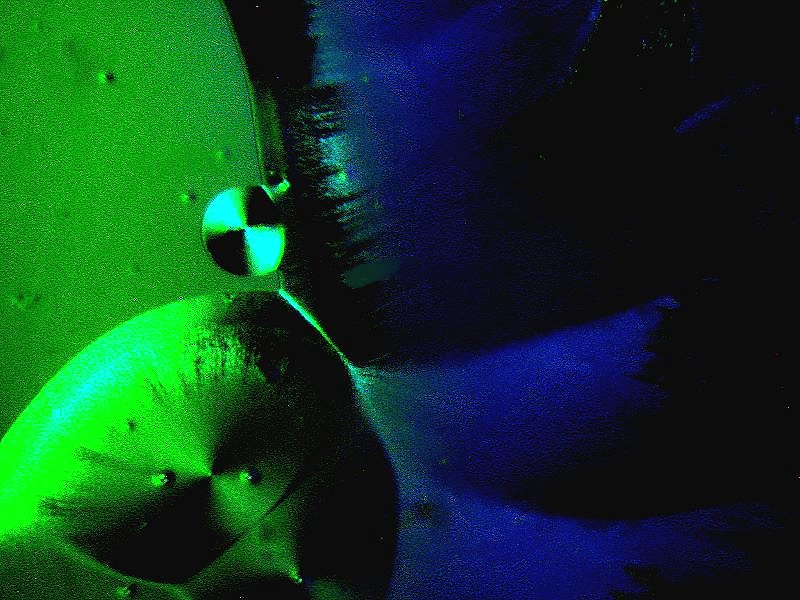
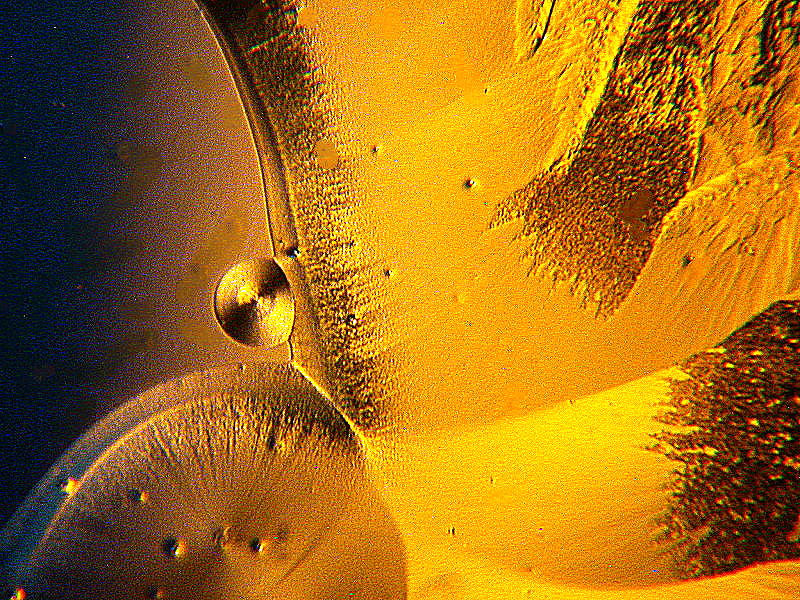
The next 2 are a combination of Gabapentin, Magnesium chloride, and Orange G. The first is a hippopotamus stranded on the rocks above a canyon and the second is a dog levitated by a very good magician.
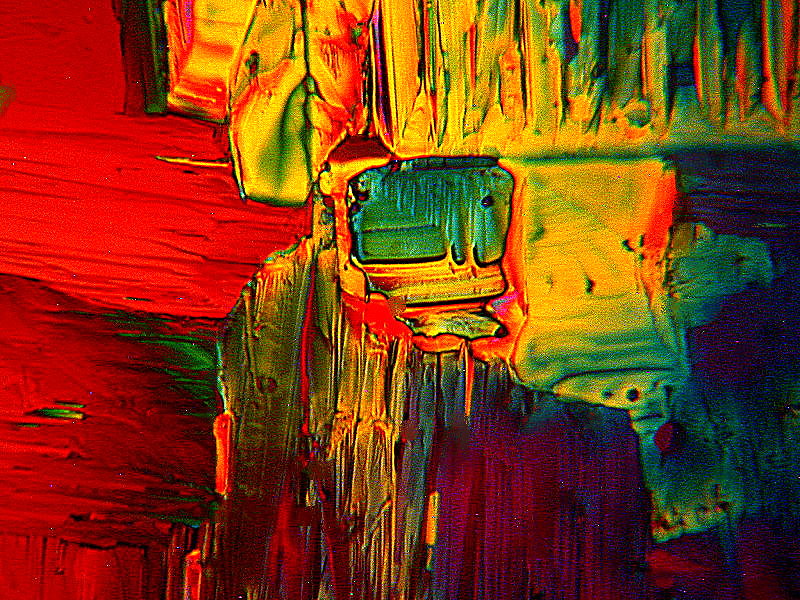
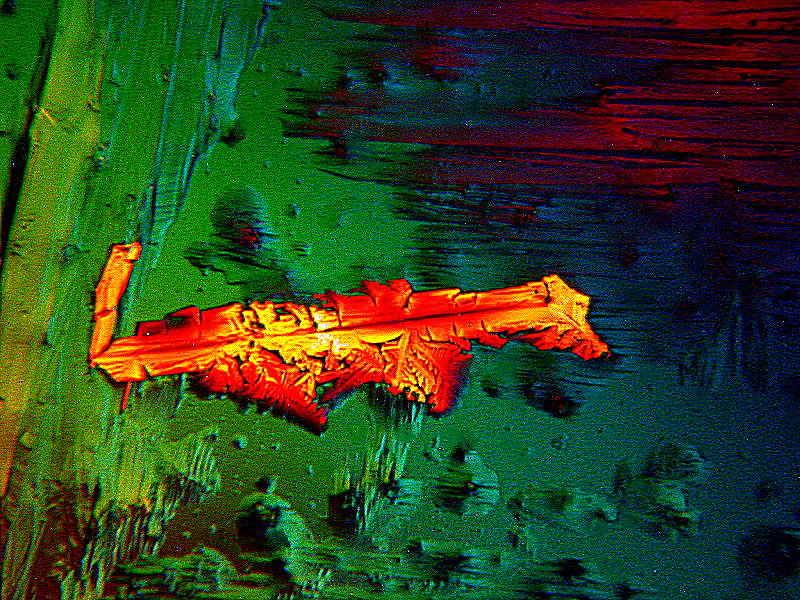
H is for Hydrocortisone which is a corticosteroid. The form I use is in a liquid preparation for the treatment of irritation on the scalp and the brand is Scalpicin. It has been mixed with Aloe. It is an interesting liquid as it produces quite unexpected results. The 3 attempts to mix it with other reagents were not successful as it tended to produce clumping. The solution alone or mixed with a small bit of 70% isopropyl alcohol seems to work best. The first image is suggestive of a part of a plant with heavy, feathery leaves.
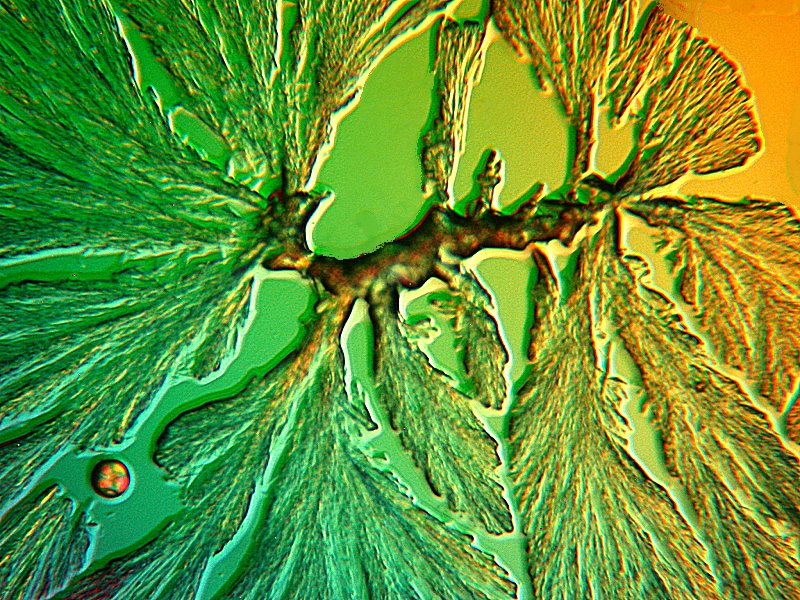
Another area of the slide shows only tiny disks scattered around. The solution produces crystals that are deliquescent and so these are still sitting in a thin solution.
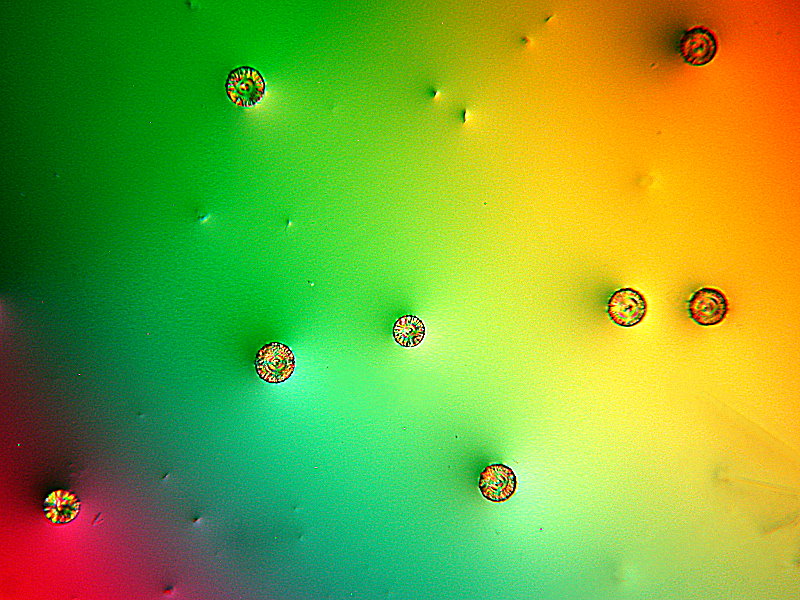
Yet the third area shows a spray of fine acicular crystals forming a large, loose disk.
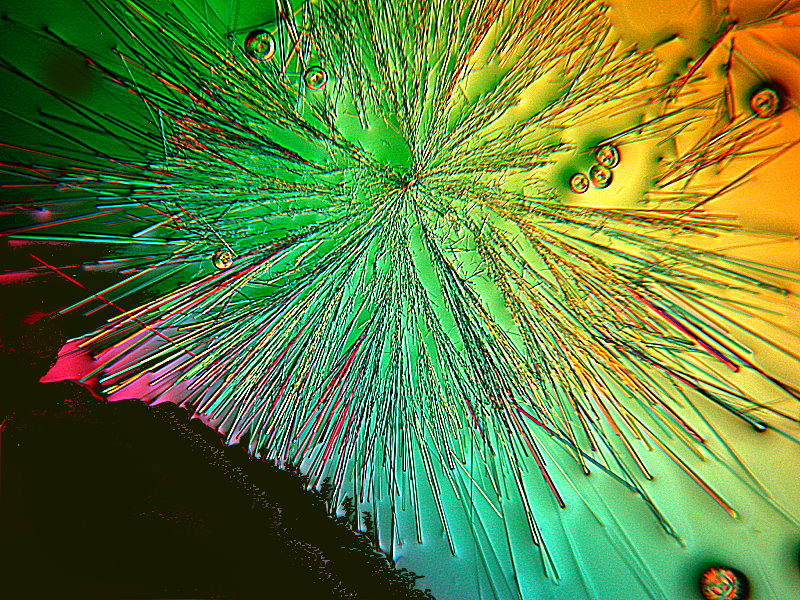
Then we begin to get areas which are combinations and in the image below we have a tiny garden of miniature mushrooms.
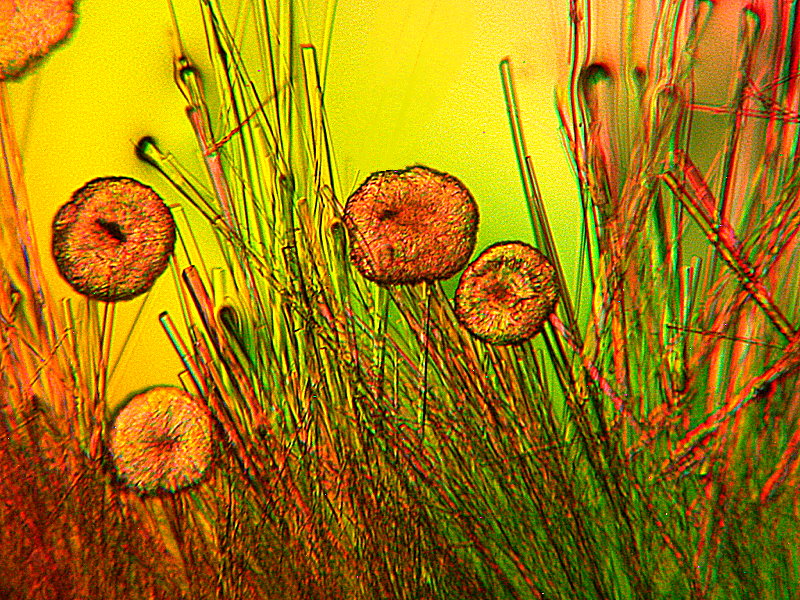
I got curious as to the character of the tiny disks but, unfortunately, most of them were not in focus due to the film of liquid which the slide insistently retained. I did, however, find one disk at the bottom of an image that looked like it might be able to be processed and so I gave it a shot and here’s the result.
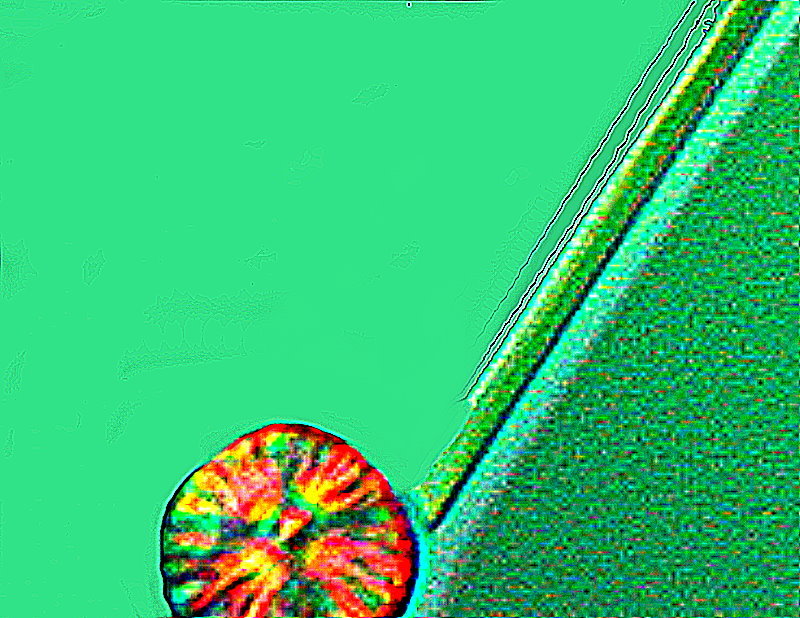
My rampant pareidolia reasserted itself and so, after a considerable amount of work, we have “Mayflies feeding”.
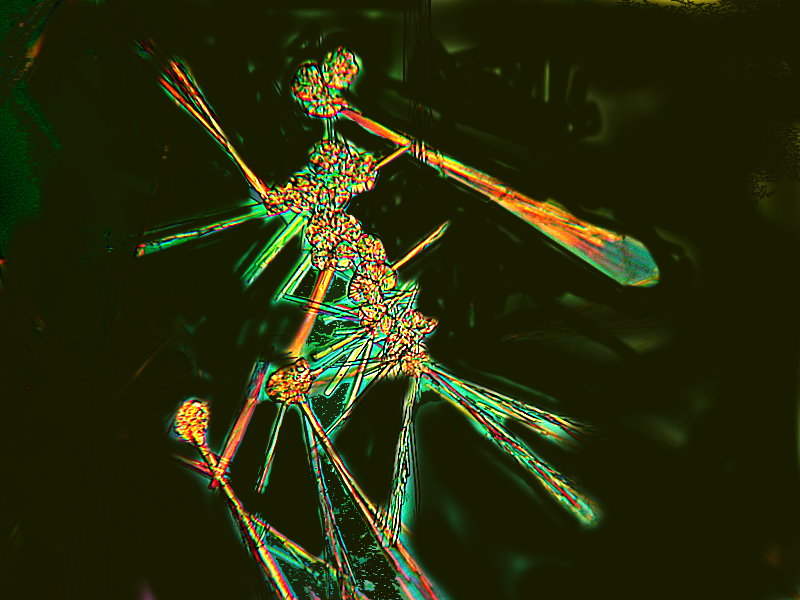
I is for Iodine. Typically, Iodine by itself forms rather geometric crystals, but when mixed with other reagents the results are quite unpredictable. In the first image, the iodine does predominate and we see some roughly geometric structures.
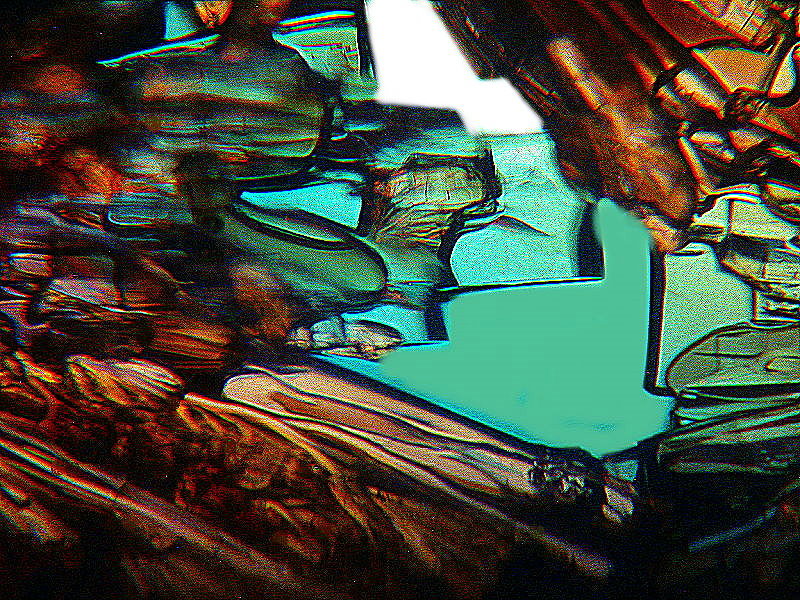
In the next 4 images, the Ascorbic acid dominates. In the first image, we see a disk, but this time it’s not one with a coherent, smooth edge, but rather the iodine has interacted in such a way as to form the disk as a series of wedges.
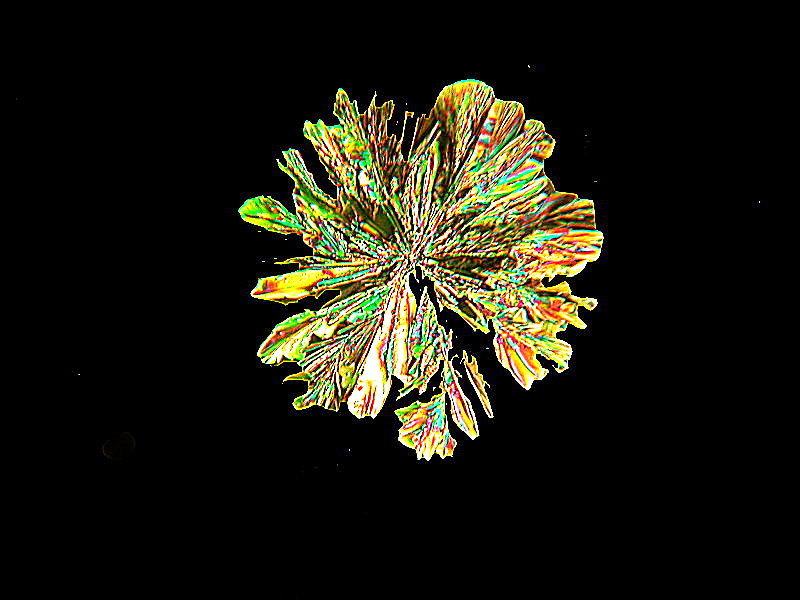
Then a full floral sunburst.
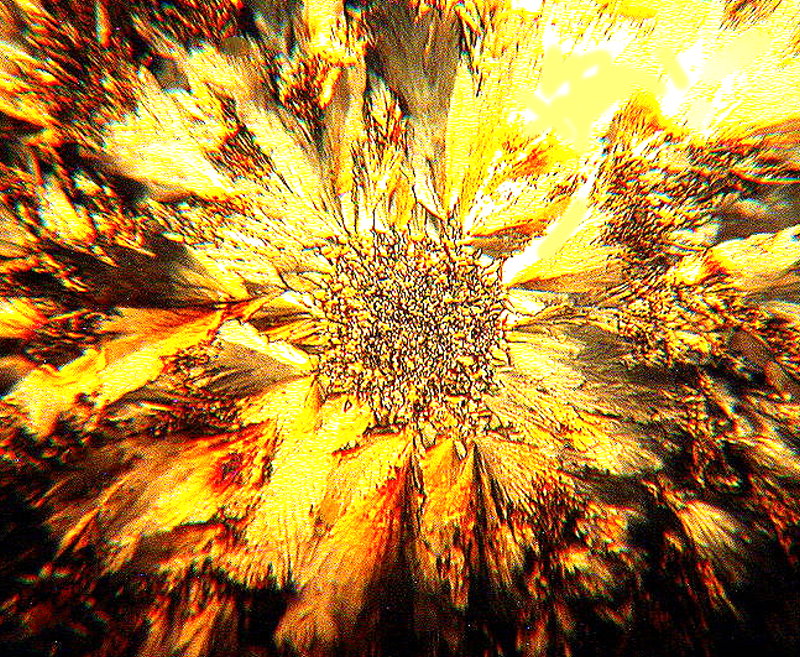
And for the vegetarians, a sack full of colorful vegetables. (For those of you who are not into philology, the etymology of the word ‘vegetarian’ is “bad hunter’).
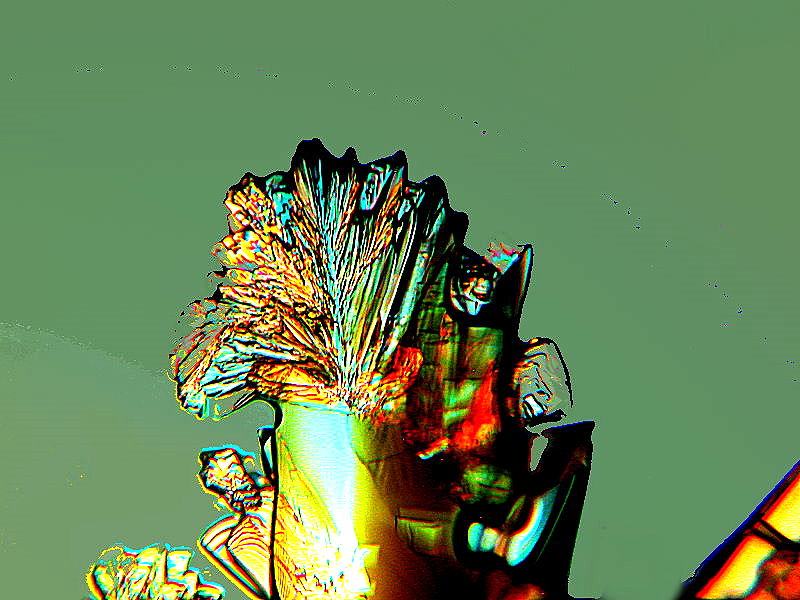
And finally, a dumbbell made of cauliflower.
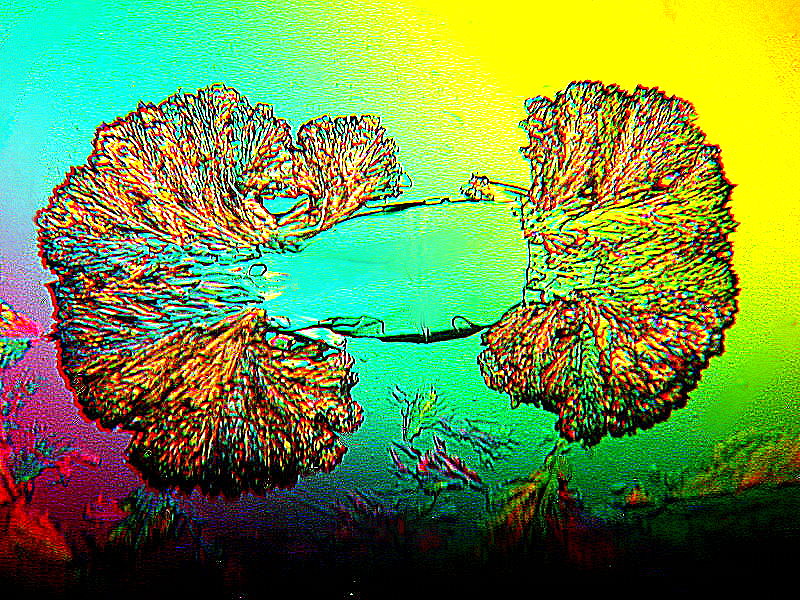
J is for Janus Green B, a biological stain whose impurities often enhance the substances with which it is mixed. The 4 images here are all with Ascorbic acid and show some intriguing properties. The first one shows us a disk such as we might expect, but with lovely, delicate pastel colors and no distinctive Maltese cross.
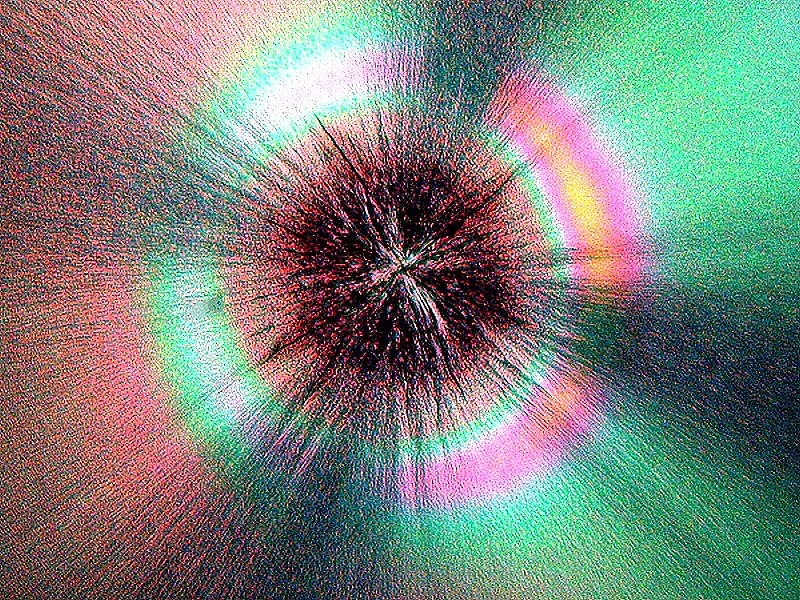
However, in this next image, we do find a sort of Maltese cross, one that has been stretched and whirled a bit as though there are beams of light emanating from the center in a colorful fashion.
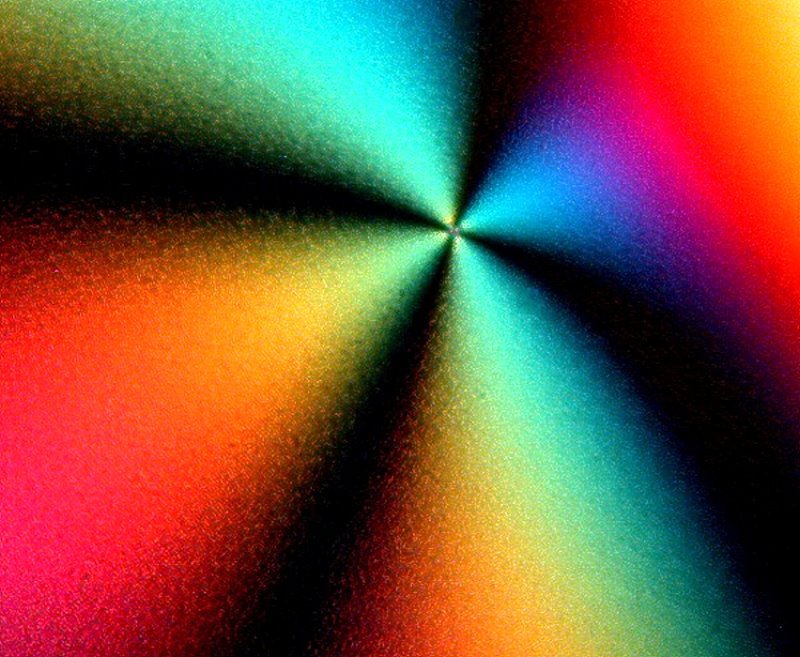
The third image is not like anything I would have anticipated arising from Ascorbic acid and is, therefore, all the more interesting to me.
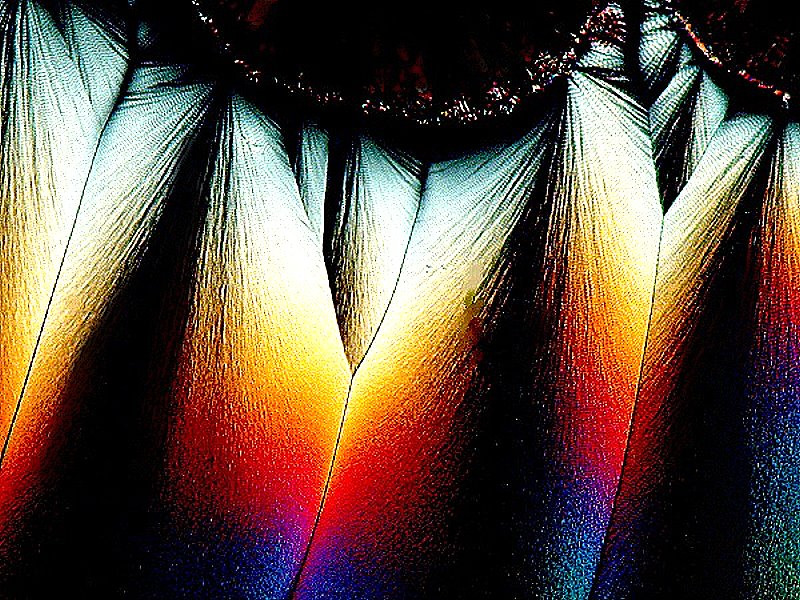
This next one is also somewhat eccentric for Ascorbic acid; there is a disk, but no center and a fringe around the disk surrounded by a roughly quadrate set of forms, but without any cross. A friend of mine described this image as “The Eye of God”.
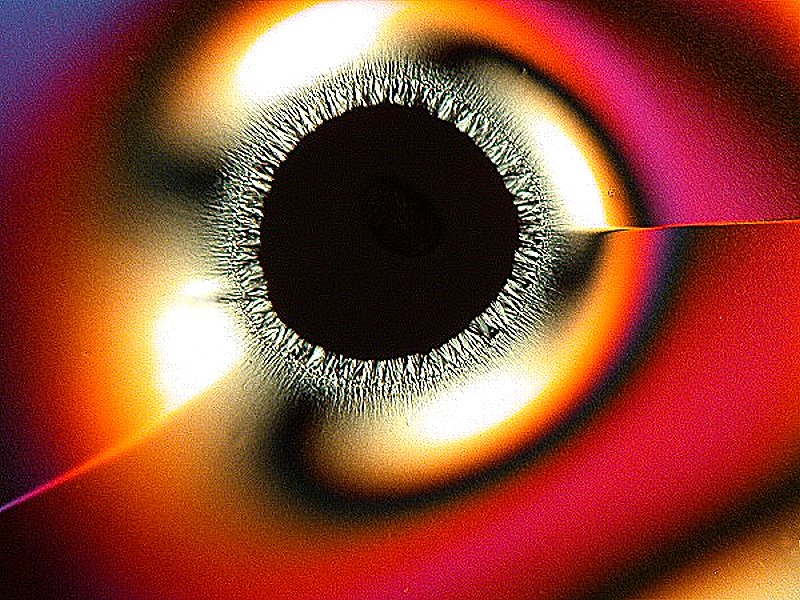
K is for KCl (Potassium chloride) and the “K” comes from the name kalium assigned by the German chemist Martin Heinrich Klaproth. I realize that using Potassium for “K” is a bit sneaky, but I couldn’t find any other substance that I had access to that began with “K”. Potassium chloride alone produces rather typical geometric forms rather like those of Sodium chloride or common table salt. Potassium salts yield marvelous crystals, especially in combination with certain other reagents, as we shall see. I particularly like the results from a mixture of KCl, Nigrosin, and Orange G. These last 2 are biological stains. First, a concatenation of strange, linearly branching forms.
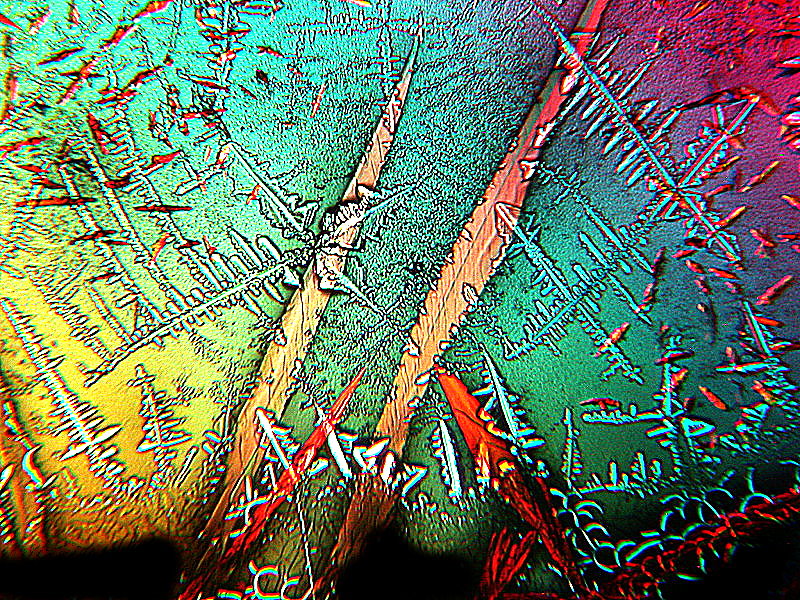
And then, using the same combination, a mountain range with a lightening storm in its foothills which overlook a bay swarming with plankton.
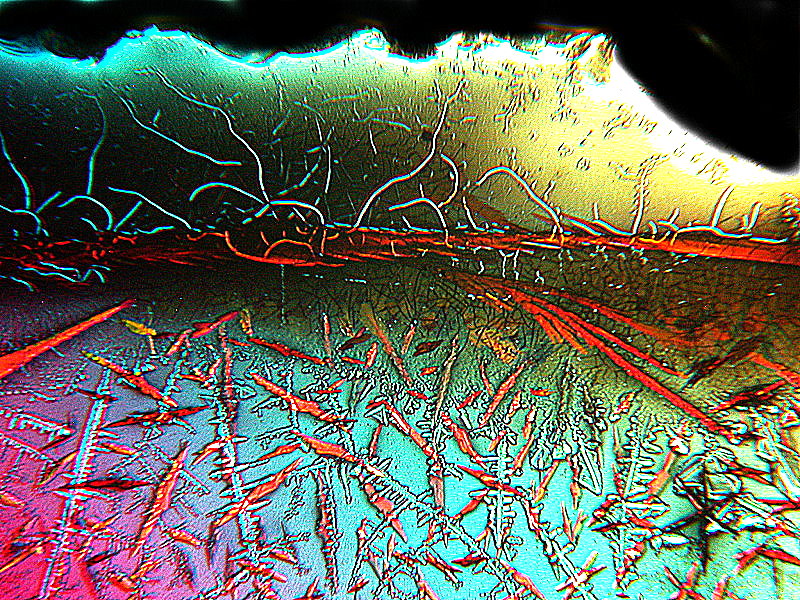
L is for Lithium chloride, another interesting salt. Here we find a mixture of images, some that trigger my passion for finding patterns and others that are reminiscent of the fluid forms of the Spanish painter and sculptor, Miro. The first is a leaf and a pod floating near a part of a branch.
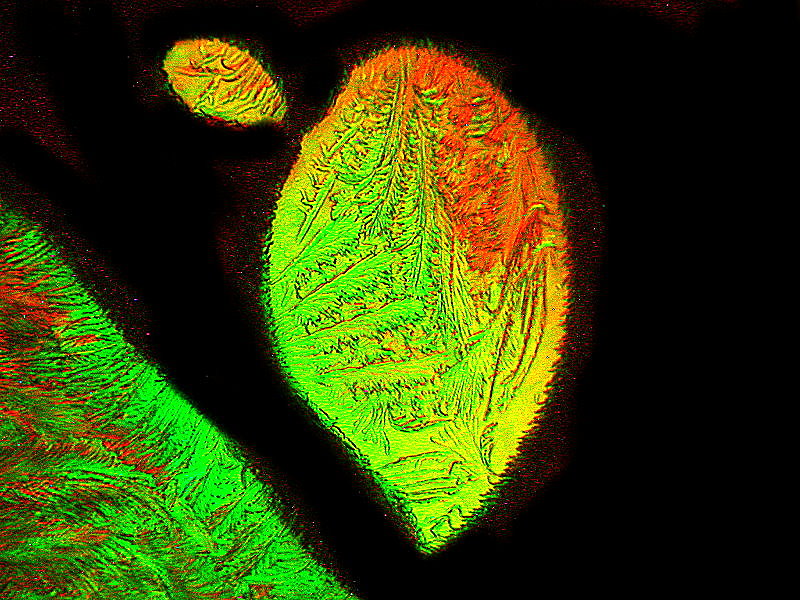
Then we encounter an extraordinarily unusual abyssal fish with a human head.
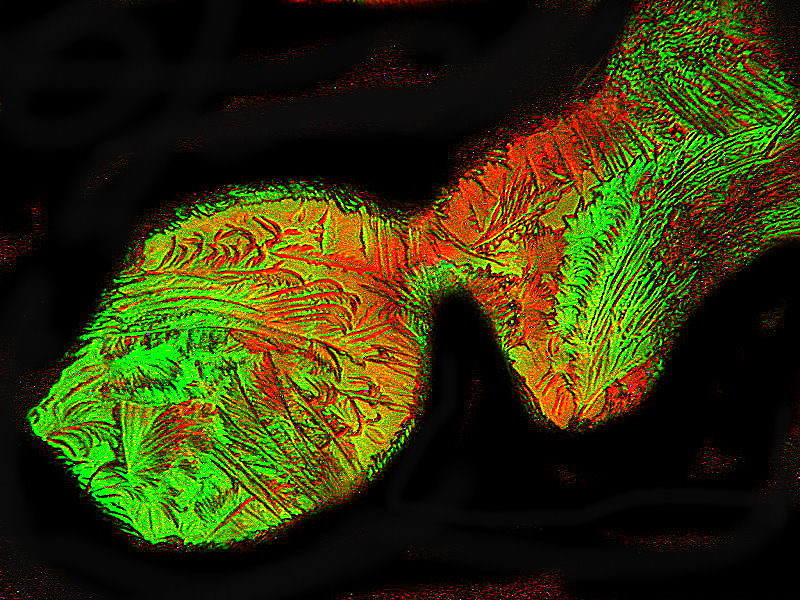
Next, I’ll show you 3 of what I call Miro-esque images; the first could be a downhill skier with an ultra-modern helmet.
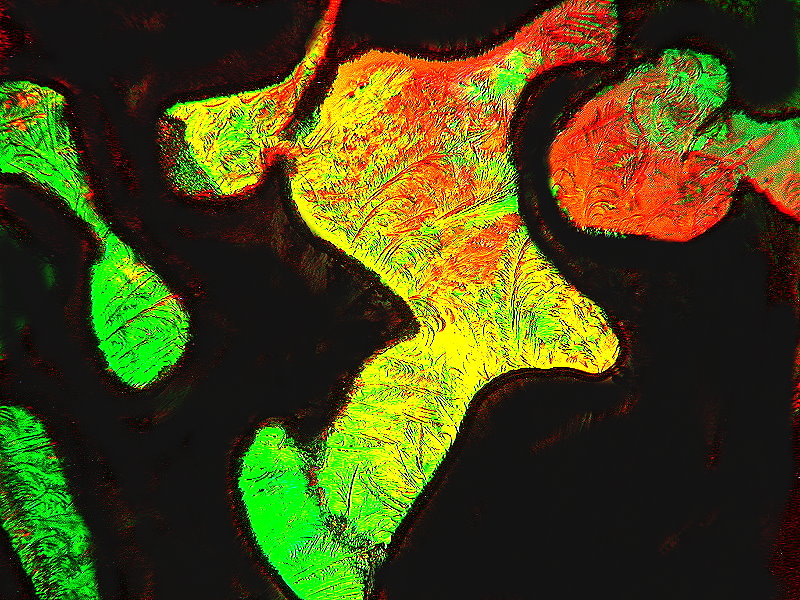
The final 3 images are more typical of the types of forms of Miro.
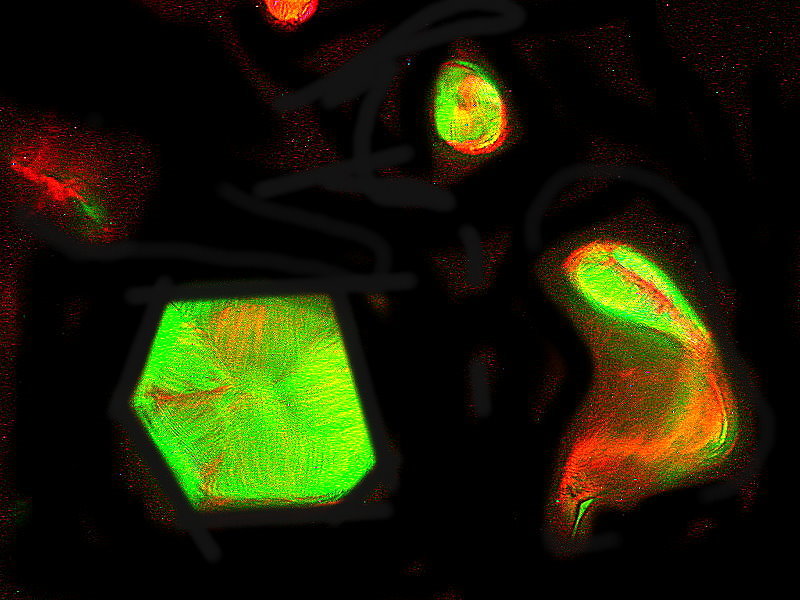
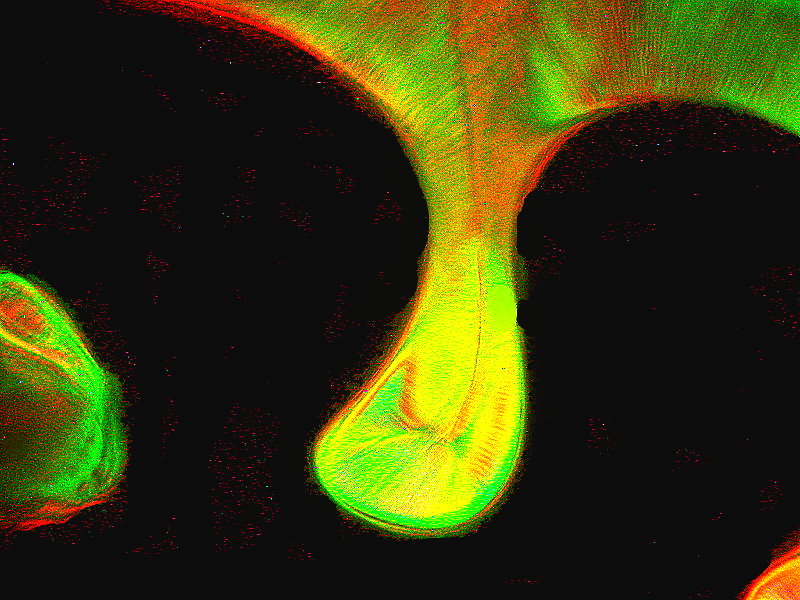
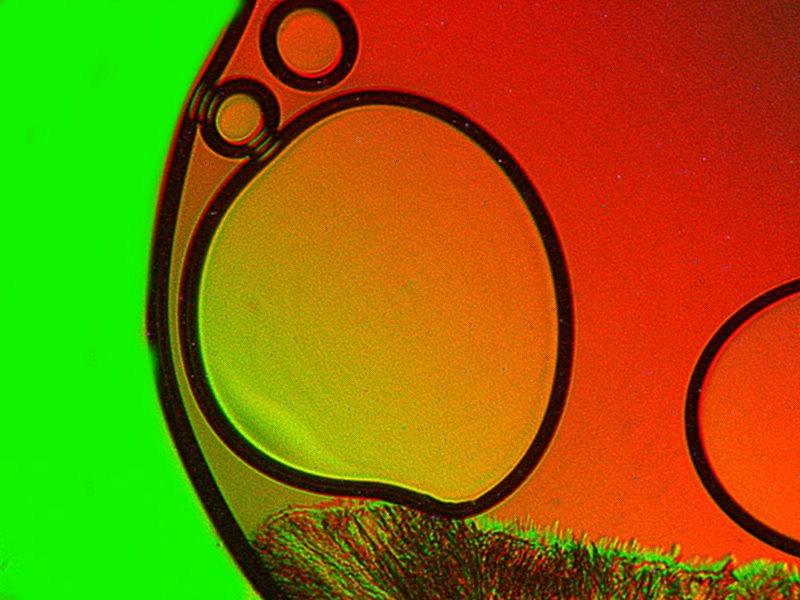
M is for Menthol. This is found in an extraordinary number of products, now fortunately banned from cigarettes. My wife used to smoke the dreadful things. I, however, stuck with unfiltered Pall Malls, but then I happened to quit about 35 years ago. Menthol is found in all kinds of pain relieving patches and creams, cough drops, chest rubs, and mouthwash just to mention a few applications. For those of us interested in crystals it has interesting properties and we’ll look at two different mixtures. First, Menthol and Stevia which is a natural sweetener derived from a plant native to Brazil and Paraguay; it is generally safe for diabetics as it has no carbohydrates. It has to be processed and then “toned down” as it is from 100 to 300 times sweeter than sugar. These first 2 images show the interaction producing sort of chunky, rather pebble-like, highly colorful forms.
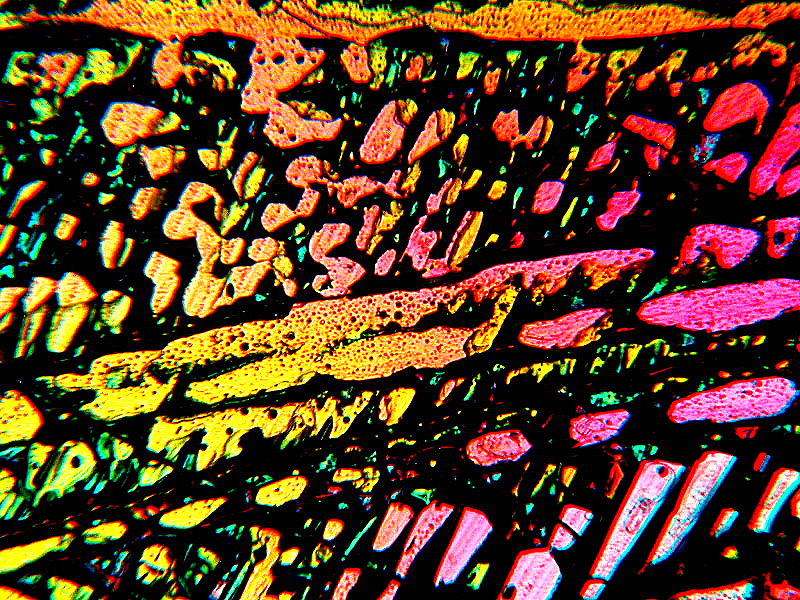
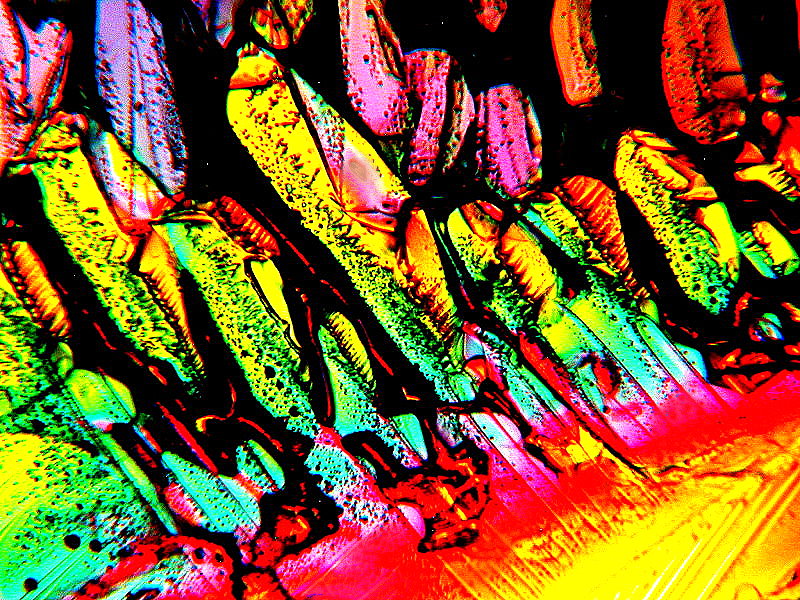
When we mix Menthol with Volmax, a medication used to treat pulmonary problems and sometime also for migraine, we still have colorful images, but now they have the appearance of feathery flowers.
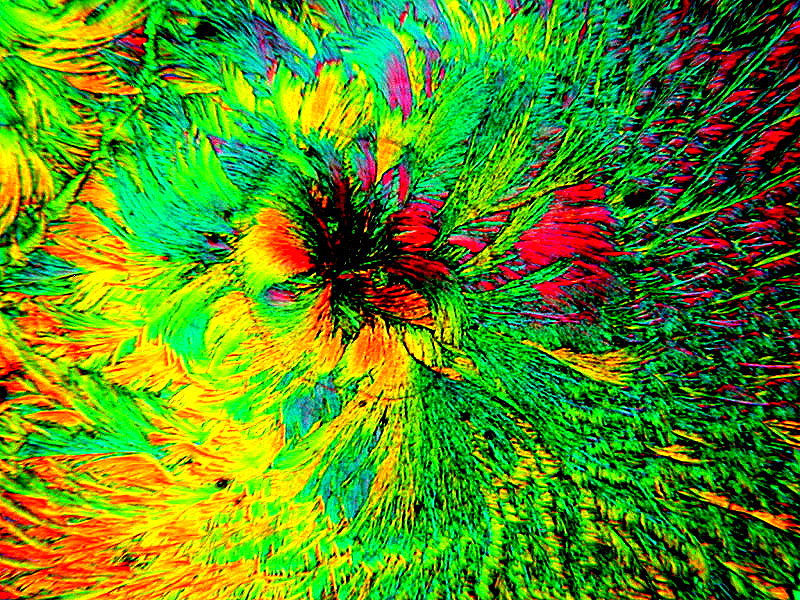
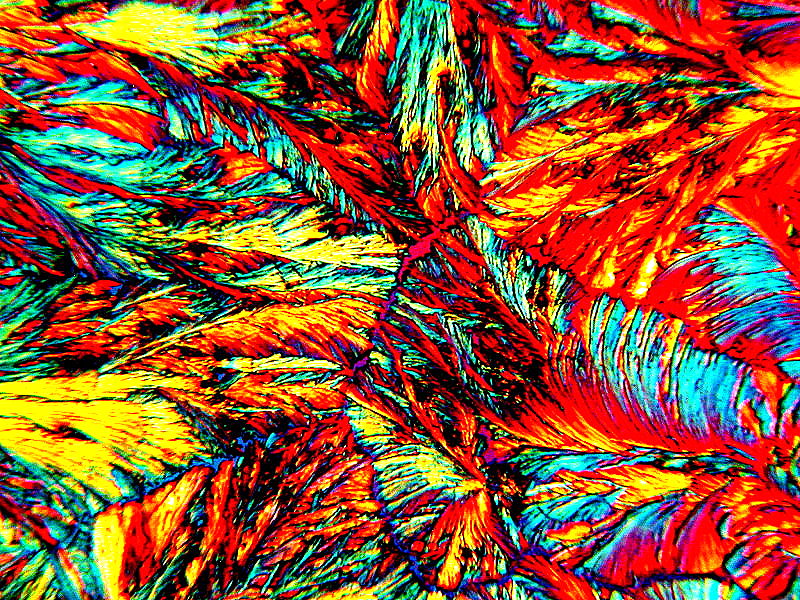
Continued in part 2, An Alphabetic Album Of Crystals N-Z.
All comments to the author Richard Howey
are
welcomed.
If email software is not linked to a browser, right click above link and use the copy email address feature to manually transfer.
Editor's note: Visit Richard Howey's new website at http://rhowey.googlepages.com/home where he plans to share aspects of his wide interests.
Microscopy UK Front
Page
Micscape
Magazine
Article
Library
Published in the September 2022 edition of Micscape Magazine.
Please report any Web problems or offer general comments to the Micscape Editor .
Micscape is the on-line monthly magazine of the Microscopy UK website at Microscopy-UK .
© Onview.net Ltd, Microscopy-UK, and all contributors 1995
onwards. All rights reserved.
Main site is at
www.microscopy-uk.org.uk .